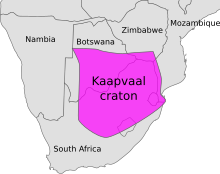Geology of South Africa

The geology of South Africa is highly varied including
Cratons and orogens

The basement of much of the northeastern part of South Africa is made up by the Kaapvaal Craton. To the south and east, the craton is bordered by the Namaqua-Natal belt.[2]
In
Tectonics and erosion since the Mesozoic
Since the Mesozoic the tectonics of South Africa have been shaped by an initial phase of
Partridge and Maud (1987) links tectonics to three cycles of landscape development: African, Post-African I and Post-African II:[4]
- African cycle: The break-up of erosion cycle that begun with the Mesozoic rifting and uplift of Gondwana ended in the Miocene, albeit judging from offshore sediments erosion was minimal already in the Oligocene,[11] an epoch that nevertheless was one of large-scale crustal deformation.[8] It was during the African cycle, 70–40 million years ago that the etchplains that characterize the African Surface formed.[11] By the Miocene the African Surface was at an elevation of 600 to 500 m.[4]
- Post-African cycle I: Erosion increased again after 150–300 m of tectonic uplift tilted surfaces to the west in the Miocene. This erosion continued until the Pliocene. Albeit erosion surfaces were eroded into existence during the cycle no well-developed planation surface was formed. The Kalahari Basin accumulated large amounts of its sedimentary fill during this cycle as did also major oceanic basins surrounding the continent. Other sediments ended up making the formations of Uloa, upper Alexandria, Bredasdorp, Elandsfontyn, Varwater.[4]
- Post-African cycle II: In the Late Pliocene the central-eastern parts of Southern Africa were uplifted up to 900 m. This uplift led to increased
Stratigraphy
Cape Supergroup
The
Karoo Supergroup
The
Transvaal Supergroup
The
Mineral resources
Diamond and gold production are now well down from their peaks. As of 2012[update], South Africa was the world's fifth-largest producer of gold but South Africa still possesses the world's second-largest reserves of gold.[14] It is the world's largest producer of chromium, manganese, platinum, vanadium and vermiculite and the second largest producer of ilmenite, palladium, rutile and zirconium.[15] South Africa is one of the ten largest coal producing countries in the world.[16][17] South Africa is also a huge producer of iron ore; in 2012, it overtook India to become the world's third biggest iron ore supplier to China, which is the world's largest consumer of iron ore.[18]
Prince Edward Islands

The
See also
- Geological Society of South Africa – A South African learned society for geology
References
- ^ "The World Factbook - South Africa". Cia.gov. Retrieved 2015-04-30.
- ^ .
- .
- ^ a b c d e f Partridge, T.C.; Maud, R.R. (1987). "Geomorphic evolution of southern Africa since the Mesozoic". South African Journal of Geology. 90 (2): 179–208.
- ^ .
- .
- .
- ^ a b c Baby, Guillaume (2016). "Mass transfer between the South African Plateau and the adjacent Atlantic Margin (Namibia - South Africa) since the Gondwana break-up". Source to Sink: a long term perspective of sediment budgets and sources characterization. Rennes, France. pp. 33–34.
- ^ .
- ^ Moore, A.E. (1999). "A reapprisal of epeirogenic flexure axes in southern Africa". South African Journal of Geology. 102 (4): 363–376.
- ^ .
- ISBN 978-0-360-00290-6.
- ISBN 978-3-540-76373-4.
- ^ "U.S. Geological Survey, Mineral Commodity Summaries, January 2013" (PDF). United States Geological Survey. January 2013.
- ^ "USGS Minerals Information: Mineral Commodity Summaries". Minerals.usgs.gov. 2015-01-30. Retrieved 2015-04-30.
- Technische Universität Bergakademie Freiberg. Retrieved 14 January 2010.
- World Coal Institute. Retrieved 14 January 2010.
- ^ "SA replaces India as China's No 3 iron-ore supplier". Mining Weekly. 2013-01-21.
- ^ "Marion Island". Global Volcanism Program. Retrieved 2015-04-30.
Further reading
- Hatch, Frederick; Corstorphine, George Steuart (1905). The geology of South Africa. Macmillan and Co., limited.
- du Toit, Alexander (1954). The Geology of South Africa 3rd Ed. Oliver and Boyd.
- Haughton, Sidney H. (1969). Geological History of Southern Africa.
